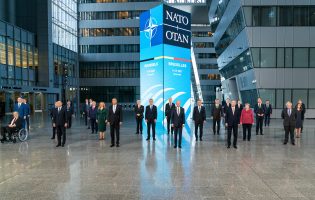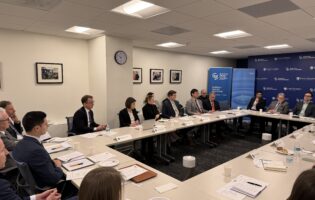A Transatlantic Comparison of Muslim Integration
On February 22, 2010, the American-German Institute (AGI) held a workshop in Berlin, Germany, on “What Role Do Religion and Culture Play in Integration? A Transatlantic Comparison of Muslim Integration in Germany and the U.S.,” which was made possible through the generous support of the Robert Bosch Foundation. The event was part of a larger project on Muslim integration and builds on AGI’s previous work on religion and politics. The three panels brought together an interdisciplinary group of experts from Germany and the United States to examine the influence of religion and culture on the integration process, immigrants, and the host country; the role of religious organizations in this process; and the role of the media.
The first panel focused on the culture and religion of the host country. The panelists examined the following questions: How do the culture and religion of immigrants’ new country factor into their integration? Are there differences between the U.S. and Germany? For example, is it easier to integrate into a very patriotic country like the U.S. as some experts have alleged? How can religion and culture of the new country and that of the Muslim immigrant be reconciled and differences managed? What kind of cultural premises make the integration of immigrants and especially Muslim immigrants easier? How can politicians and politics help – is the German Islam Conference a model? What kind of role does Islam play in the German and American education systems? In civic society?
In the U.S., the Muslim community is younger and better educated than the majority of the U.S. population. In terms of Muslim integration in the U.S., September 11 constitutes an important shift in their relations with non-Muslim Americans: Muslim immigrants were identified in a security context and assigned a pan-Middle Eastern identity. Studies called for a speedy integration into U.S. society and urged American Muslims to stress their opposition to terrorism; the tone was rather U.S.-centric. Since 9/11, 60 percent of Muslims in the U.S. have stated that they have experienced discrimination. In the U.S. as well as in Germany, the secular state formulates the political and institutional framework in which Muslims live and practice their beliefs.
In Germany, Muslim migrants have traditionally come from a lower socio-economic class, a characteristic which is also reflected in the social and intellectual gap of Muslim organizations. Migrants were initially more concerned with developments in their countries of origin, as few possibilities to participate were awarded to them by the German system. Consequently, the Muslim organizations were oriented toward the countries of origin, particularly Turkey. This has changed with the second and third generation of Muslims in Germany, who are more educated and more focused on Germany than previous generations. Still, some second and third generation immigrants are more interested in cultural issues than mobilization, causing Muslim organizations to have a lack of educated, German-born leadership. Religious leadership often comes from outside of Germany: Imams are born and trained abroad and lack both a grasp of life in a European country and German language skills. Thus, the creation of theological professorships in Germany should be supported and education for theologians and Imams in Germany must be expanded. German society has long neglected to focus on the integration of immigrants and Islam; school children still lack the option of studying Islam in school. Islamic religious lessons should be made available in all German schools. While the state and society slowly begin to realize the need for integrating Muslims and Islam, Islam is still considered a “foreign religion” in Germany and usually portrayed as very monolithic. After 9/11, many secular and/or cultural Muslims were defined as “Muslims” in a religious way. For non-Muslim Germans these religious criteria functioned to ostracize Muslims and for Muslims it served to reinforce their self-understanding.
It is also important that Germany learns from the United States in recognizing that the problems immigrants face are social in nature and not religious. In the U.S. it is important to note that Islam is not regarded as a foreign religion, notable because the African-American community is largely Muslim. American society accepts and supports the role of religious organizations in integrating immigrants, whereas Germany is a rather secular society in which secularism is equated with modernity. While discrimination against Muslims also occurs in the U.S., Muslims can draw on the long American history of social or religious groups overcoming discrimination and thus find their experience as not unique; one could especially compare Muslim integration with the path taken by Catholics, who were suspected of having a greater allegiance to the Pope than to their new state; similar claims have been made about Muslims and their allegiance to the “Umma.” As religious organizations in the U.S. have found a way to formulate an American Islam, German Muslims should undertake this process as well in developing a German Islam.
The second panel addressed the role of religious organizations. The following questions were addressed by the panelists: New immigrants in particular find support and guidance within their religious communities; is this also the case for Muslim immigrants in Germany and the U.S.? What state regulations govern these religious organizations? Do the religious organizations ease integration or do they prevent a successful integration by limiting the contact between immigrants and natives? Are immigrants becoming more religious in their host countries as religious organizations provide them with social stability and cohesion and familiar structures? What role do religious organizations play in advancing immigrants’ rights and their integration? Are the second and third generations also interested in the religious organizations of their immigrant parents or do these religious organizations change? Is there a difference in the U.S. and in Germany and if so what is the difference?
Germany has experienced a shift in its integration policies in recent years. Prior to the last decade, Germany did not see itself as a nation of immigrants and had adopted a rather laissez-faire approach to Muslims and matters of integration. The shift has occurred not only because of 9/11 but also because Muslims themselves have started a quest for more recognition and integration, which now the state tries to regulate. Muslim religious organizations in Germany have not only a religious purpose, but also function to enable their members to find like-minded people. In the past religious organizations and mosques were located mainly in the private sphere but are increasingly entering the public sphere (e.g., with the building of more prominent mosques) and are becoming part of all facets of German society. In the U.S. Islam encountered freedom and modern values. From the beginning, religious organizations such as the Islamic Society of North America (ISNA) were constructed as inter-faith groups intended to enter into dialogue with other religions. This process and dialogue has also helped the Muslim community in the U.S. to discuss very sensitive issues such as the Middle East conflict to avoid having this issue become divisive in the United States.
The third panel analyzed the role of the media by examining the following questions: What is the description of Muslims in the German and American media? What consequences for public opinion does this perception have? What kind of issues vis-à-vis Muslims and immigration are covered in the German and American media? Are the reporting and the selection of topics biased? How do Muslims perceive the role of the media? What media and PR work do Muslim organizations do and how successful are they? Are topics related to religion more controversial in Germany than in the United States? Does the framing of stories on religion in the United States and Germany reflect different assumptions about secularism, modernity, and religion as well as a different level of integration of Muslim immigrants in the U.S. and Germany?
In the U.S. it is rather difficult to write about sensitive issues; Islam and Muslim immigrants are among those sensitive issues. Muslims are a relatively new group in the United States and have not been a very visible group among recent immigrants. Consequently, they do not have much experience dealing with the media. After 9/11 journalists’ interest in this group grew exponentially. While in the beginning there was little selectivity in acting as a spokesperson for the Muslim community, with time the Muslim community became more media-savvy and non-Muslim journalists became more experienced and more nuanced in their reporting. Yet the media is still perceived as being against Muslims by the Muslim community, which is also highly sensitive to negative reporting. Public onion polls in the U.S. paint a picture of this bias: 58 percent of U.S. citizens believe that Muslims are discriminated against and a majority would not vote for a Muslim. The U.S. media relies on certain themes to describe Islam (usually as a sexist and violent religion); only one quarter of Muslims feel they are portrayed correctly in the U.S. media. The 24 hour news cycle clearly contributes to the perpetuation of stereotypes. One example is the recent attack on an IRS building in Austin, during which reports first suspected terrorism. When it became clear that it was a disgruntled white man who had committed the attack, however, it was not considered terrorism, as if only Muslims attacks are terroristic in nature. The younger generation of Muslims in the United States also seems to more susceptible to radical ideas perpetuated in blogs and on the news media, evidenced by the arrest of five American Muslims in Pakistan on terrorism charges.
In Germany, not a single practicing Muslim can be found on television, and only 1 to 2 percent of migrants work in the media, leading to a lack of Muslim perspectives. The media coverage in Germany is issue driven, but it also tends to be highly biased and focused on hot topics (e.g., terrorism, the suppression of Muslim women), rather than on Muslim daily life. This of course shapes the image in the public mindset. As in the U.S., the 24 hour news cycle perpetuates stereotypes by focusing on radical Muslims, which in reality represent only 0.1 percent of all Muslims. However, as Muslims become more and more a part of Germany politically, their voices are heard more often in the media. Muslim blogs and a stronger presence in online media in Germany are emerging, yet this remains a very small part.







